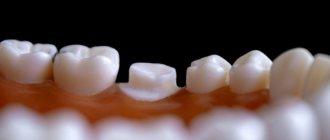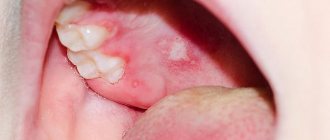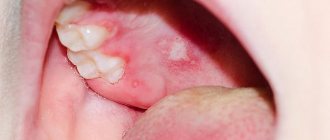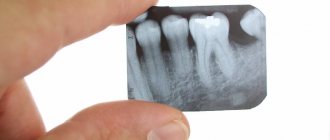The drainage system is installed in stages:
- The painful area of the jaw is numbed.
- The gum is cut and a latex drain is inserted into it, through the hole of which the pus is sucked out.
- After suctioning out the pus, an antiseptic drug is injected into the gum incision.
- If a tooth is removed, the gum is not cut, but a drain is inserted into the socket.
How many days should I wear the drainage? Improvement may occur within 24 hours. On average, drainage costs from 3 to 5 days.
Why is medical drainage used in dentistry?
Elimination of purulent diseases of the oral cavity often requires the installation of drainage. This product is a thin tube or strip. It can be rubber or latex. The material is moisture resistant, so it retains its qualities when in contact with saliva. Main functions of drainage:
- removal of purulent exudate from the source of inflammation;
- preventing wound healing until it is completely clean;
- providing access to the incision when it is necessary to introduce drugs into the infected tissue.
When the drainage is installed correctly, the patient almost does not feel it in the mouth. If you feel discomfort or even pain, you need to contact a specialist again.
Almost any disease of the oral cavity, during the development of which an infection is added, requires treatment with the installation of drainage. Most often these are dental diseases:
- pericoronitis – inflammation due to difficulty in teething (in adults this is an incorrectly positioned “figure eight”);
- alveolitis - the development of a pathological process in the socket after tooth extraction;
- periostitis - inflammation of the periosteum;
- periodontitis – involvement of the tissues that hold the tooth in the disease process;
- cyst or abscess, periodontitis
Suppuration may appear as a result of an injury (during complex tooth extraction, damage to the jaw, etc.). For the pathologies described above, drug treatment alone will not help. It is imperative to create an outflow of pus.
Dentist advice
If you follow the doctor's recommendations, the effectiveness of the drainage system increases.
- After installing the drainage, you can eat only a few hours later. Food should be liquid.
- You can take a painkiller tablet to relieve pain.
- Drainage is installed when a purulent process occurs, so you should not apply a heating pad to your cheek. It is better to apply a cloth soaked in cool water
- It is better to sleep on the side opposite the side on which the drain is installed.
- If drainage is installed, it is better to stop smoking and drinking alcohol.
- Be careful when brushing your teeth.
- Avoid injuring the gums, as impacts can dislodge the drainage.
In order for the gums to heal well and without complications after removal of the drainage, the patient must follow the recommendations of the dentist, who can provide comprehensive assistance in the treatment of the inflammatory process that occurs at the root of the tooth or in the gum.
Drainage in the gums: what is it, what to do in case of accidental loss
Untimely treatment of many dental diseases can provoke complications in which pus accumulates in the tissues.
Popularly, this pathology is called gumboil. To eliminate it, endodontic treatment is performed. But, unfortunately, it does not always give a positive result. In this case, the help of a surgeon is required. After the manipulations, the doctor installs drainage in the gum. If many processes do not raise questions among patients, then it is not always clear why the last stage is being carried out. How is drainage installed, for what purpose is it used, what are the features of its application? Let's figure it out together.
Contraindications to gum drainage and possible complications
The procedure is not performed in the following cases:
- bleeding disorders;
- individual intolerance to anesthetic substances;
- unstable mental health.
What to do when drainage is impossible? In this case, alternative methods of disinfection and cleaning of the affected area are used. Even when the procedure is performed as indicated, complications are possible. This may include bleeding, ulcers, pain, or increased body temperature. To identify the cause of the complication and eliminate it, you need to visit a dentist.
What to do if the tube falls out?
The patient must understand what happens during the drainage process. This is the only way he can respond to changes in time.
- If the dental drainage falls out on the first day of therapy, when the swelling has not yet gone away, you should urgently contact your dentist to install a new system. You cannot hesitate to visit a doctor, since the soft tissues quickly unite, preventing the pathological fluid from escaping.
- You should not return the structure to the wound yourself, so as not to cause additional infection and the development of serious complications.
- When the strip or tube falls out after 4-5 days, the swelling has already subsided, pus does not flow out of the wound, there is no need to worry. This means that the design has fulfilled its functions. But you need to see a doctor. He will monitor the patient’s condition and, if necessary, prescribe further treatment.
To prevent tooth drainage from causing inconvenience to the patient, it must be placed correctly. It is better for the patient to sleep on the healthy cheek, and not on the side where the operation was performed. This will not move the system away from the inflamed area. If you can’t see a doctor, the tumor has gone away, and there’s no pus coming out, you can try to remove the system yourself. To do this, stand in front of a mirror and, with great care, pry off the tube, pulling it smoothly towards you. But, it’s better not to take risks, but to find a way to get to the doctor and entrust this manipulation to a specialist.
Contraindications
Dissection of soft tissues with further installation of drainage is not possible in all cases. Among the prohibitions to the procedure are:
- pathologies associated with blood clotting disorders;
- allergy to painkillers used before the procedure.
In the latter case, the doctor must select a drug that does not cause adverse reactions in the patient. There are no other contraindications to drainage. If the cheek is swollen, and necrotic masses have accumulated in the periodontal tissues, then the easiest way to deal with the problem is by installing drainage.
How long to keep gum drainage?
Since cases are different, the treatment required for different diagnoses is also different.
And only the attending physician can tell you exactly when to remove the drainage from the gums.
Removal of tooth drainage in most cases is done in a fairly short period - up to 3 days.
If the drainage needs to be changed, the dentist will definitely warn you about this and make an appointment for the day when the replacement will be carried out.
Sometimes you have to visit him every day, because the procedure for installing drainage on a tooth on your own at home is impossible.
During a routine removal of an inflamed wisdom tooth, for example, you can wear drainage for 1 day.
In other cases (for example, after a complex operation), you can walk with it for a week (as long as the course of drug treatment lasts).
A very important point: drainage should not greatly interfere with the person or cause pain.
In such cases, the drainage must be removed, the cut cleaned, and a structure made of a different material installed. Removing the drainage and inserting the one that has fallen out is best left to professional dentistry.
Drug therapy
In the treatment of purulent processes, antibiotics are necessarily used. They reduce the risk of recurrent infection. Typically, your doctor will prescribe metronidazole with lincomycin or clindamycin. This combination of drugs allows you to act on gram-positive and anaerobic bacteria.
Metronidazole is prescribed orally, lincomycin and clindamycin are prescribed in the form of tablets or intramuscular injections. Lincomycin is used with caution, as this drug can cause allergies.
Metronidazole is prescribed orally, lincomycin and clindamycin are prescribed in the form of tablets or intramuscular injections. Lincomycin is used with caution, as this drug can cause allergies.
How to rinse your mouth after tooth extraction: list of products
There are several groups of drugs for sanitation of the mouth after dental surgery. Some kill the infection, others promote the restoration of the mucous membrane. How to rinse your mouth after tooth extraction in your particular case will be determined by your dental surgeon. Don't make your own appointments.
When choosing a medicine, the doctor evaluates several factors:
- condition of the wound;
- complexity of the operation;
- patient's age;
- individual intolerance to some components.
Let us briefly look at the most effective and popular solutions in dentistry.
Miramistin is a leader among antiseptics with a wide range of applications. Acts against infections of bacterial, fungal and viral nature. The product is produced in the form of a solution and an aerosol. The concentration of the active component is 0.01%. Usually 3-4 rinses are prescribed per day for up to a week. The medicine can be used at any age, during pregnancy and breastfeeding.
Chlorhexidine is the next most effective antiseptic drug. Disinfects wounds from bacteria, some viruses and protozoa. For dental procedures, a 0.05% solution is used. Prescribed in the form of baths and rinses three times a day. A huge advantage of chlorhexidine is its prolonged action: the antiseptic effect remains for another four hours after use.
Furacilin is a long-known strong antibiotic. In addition to disinfection, furatsilin also promotes wound healing. The medicine is released in tablet form. You need to prepare the solution yourself by mixing 1 tablet in 100 ml of saline solution. Rinse the wound 3-4 times a day for 5-6 days.
Chlorophyllipt is a disinfectant solution that is especially harmful to staphylococci. Works great in patients with concomitant chronic tonsillitis and pharyngitis, as they are most often caused by staphylococcus. The course of treatment is prescribed individually.
Traditional medicine recipes do not lose their relevance. Properly prepared decoctions and infusions of medicinal herbs are useful: chamomile, calendula, oak bark, sage, St. John's wort.
But what doctors do not recommend are solutions that contain salt, iodine, brilliant green, and potassium permanganate. These components have an irritating effect on the diseased mucous membrane and can cause a chemical burn.
The most complete reminder for patients after tooth extraction
So, you left the doctor's office - the surgeon asked you to tightly squeeze a gauze pad with your teeth, which will help stop the bleeding. You need to hold it for about 20-30 minutes, that is, while you fill out the necessary documents at the clinic or go home. Remove the tampon carefully, moving it slightly to the side, without sudden movements, so as not to damage the fresh blood clot.
Very important! A thrombus (usually called a “blood clot”) protects the wound from microbes and prevents pieces of food and saliva from accumulating in the hole during the first week of rehabilitation. This is a natural sterile dressing that starts the process of new tissue formation. The most important rule that will protect you from complications and severe inflammation of the wound is to never remove the clot, do not touch it with your tongue or fingers, do not touch it with a toothbrush and protect it from other influences. Gradually it will resolve on its own.
Do not keep the tampon in place for more than 30 minutes - gauze soaked in blood and saliva will quickly become a breeding ground for infection. In addition, a blood clot is forming in the hole - the presence of a foreign body and additional injury are of no use to it. You need to give the wound the opportunity to heal naturally.
“If you have a complex tooth extraction, especially if you had surgery to remove wisdom teeth, or if you have an underlying condition, such as diabetes, you may need to observe a doctor for a few more hours.
For this purpose, we have our own hospital, where you can sit comfortably and relax while we monitor your condition to see if there are any complications. This will give us confidence that the operation will be successful and will reassure you as the patient.” Vasiliev Alexander Alexandrovich, implant surgeon, work experience of more than 9 years, make an appointment for tooth extraction WITHOUT complications!
The modern equipment of our clinic allows us to carry out the most accurate and comprehensive diagnostics. Consultation is free!
Sign up online
Swelling after tooth extraction (especially if it was complicated) can be prevented by applying a cold compress - to do this, wrap an ice pack from the freezer in a towel and apply it to the cheek (that is, from the outside) for no more than 20 minutes. After 15 minutes the procedure can be repeated. If you don't have ice on hand, frozen vegetables or meat will do, but be sure to wrap them in a bag and a towel to avoid cold burns. Cold constricts blood vessels, reduces pain and swelling, although it does not completely remove swelling. Compresses are effective immediately after surgery for approximately 3-4 hours.
Do not warm up the injury site under any circumstances! A hot compress will only make the swelling worse by increasing blood flow to the area of inflammation. This will lead to serious complications after surgery.
Indications
Normally, local mucosal immunity is able to protect the wound from infection. Saliva contains a natural antibiotic - lysozyme, which destroys pathogenic microorganisms. Thus, the wound cleanses itself. But there are situations in which local protection weakens and there is a risk of complications.
Rinsing after tooth extraction is indicated in the following cases:
- Inflammation (pulpitis, periodontitis) appeared before the operation.
- The gums were opened and there was additional trauma. For example, if there was flux and drainage was installed.
- There are untreated inflammatory diseases in the oral cavity: stomatitis, carious teeth, tartar.
In these conditions, there is a high risk of infection of a fresh wound. In these cases, rinsing is needed to disinfect, destroy bacteria, and reduce the risk of complications. Often in such cases, additional oral medications are prescribed: antibiotics and anti-inflammatory non-steroidal drugs.
How and for how long drainage is installed
The drainage procedure involves performing the following actions:
- anesthesia of a specific area or the entire cavity;
- incision of the gum in the area of suppuration;
- artificial pressure build-up for cleaning purposes;
- cavity disinfection;
- drainage - installation of a strip or tube.
Only a doctor can tell you how many days drainage is installed. It all depends on the diagnosis and the complexity of the clinical picture. More often, the tube is removed three days after surgical procedures. But the timing may vary in one direction or another. So, if a wisdom tooth has been removed, the drainage can be removed after a day, although it is rarely installed during such an intervention. When a complex surgical procedure was performed, you will need to wear it for a week. If the abscess is not serious and the inflammation has not returned, there is no need to change the gum often. If necessary, the doctor will set a date for the next visit.
It is better to have a doctor remove the drainage. He must ensure that the procedure is completed successfully. Otherwise, a relapse may occur. When the swelling subsides, this indicates complete cleaning of the wound and the beginning of its healing. Independent extraction is possible with the permission of a doctor and after instructions. To do this, you need to thoroughly wash your hands, disinfect your mouth, and pull the free edge of the strip or tube in front of a mirror. The actions are simple, but unsafe, so it’s better not to take risks.
Tags
removal of a tooth.removal of a tooth.over a tooth.hood of a wisdom tooth toothache; wisdom tooth removal;brushing teeth and brushing teeth nearby with a soft toothbrush.tooth extraction or Dental prosthetics Prosthetics on Prosthetics on Prosthetics during Dental prosthetics Treatment Treatment process of treatment of diseases simplifies the treatment of soft ones; Interrupt treatment immediately; time of treatment is desirable Treatment of Methybefore timeliness of treatment and drug treatment. and treatment.
implantationpricesbite bracesarticleprostheticsservicesreviewsveneerschildrenwhiteningcrownsimplantshygiene
How long does it take to recover after draining pus?
The healing time of the incision depends on the complexity of the clinical picture and the medications used, including antibiotics. To speed up recovery, you must follow the recommendations of specialists:
- do not sleep on the sore side;
- limit physical activity;
- eat soft diet foods;
- refuse hot drinks and food;
- Avoid putting foreign objects into your mouth. This will prevent re-infection;
- take all prescribed medications.
After successful removal of pus, you should not stop treatment. Experts recommend rinsing your mouth with one of the solutions for several days: “Chlorhexidine”, “Miramistin” or hydrogen peroxide (1 tablespoon per 200 ml of water).
If the drainage has been left in place for the allotted time, and after it is removed, the wound swells again and begins to hurt, you need to visit a specialist as soon as possible.
When will the gums heal?
This question interests many patients. The rehabilitation period after molar tooth extraction can be longer or shorter. This depends on the severity of the operation, the amount of collected pus, the condition of the gum tissue, and the presence of chronic diseases. In difficult cases, the patient will have to visit the doctor every day so that the dentist cleans the wound and administers a dose of the drug. If there are no complications, the gum tissue heals quickly. For some people, the healing process takes 3-4 days. It happens that complete rehabilitation takes a week or ten days.
The doctor may prescribe treatment of the oral cavity with an antiseptic solution to prevent the development of infection in the mucous membrane. For this purpose, miromistin and hydrogen peroxide are used. Soda solution, Cholisal gel, and chlorophyllipt solution are also suitable. The ointment used is solcoseryl and levomikol. According to indications, antibiotics such as Lincomycin, Doxycycline, Amoxiclav are prescribed. For unbearable pain, you can use Tempalgin, Ibuprofen, Ketanov according to the instructions. If you follow medical recommendations, healing occurs quickly.
Why install drainage?
In dentistry, drainage is used in the following cases:
- for tissue healing after removal of a problematic tooth;
- with alveolitis;
- after opening the flux;
- when an abscess or cyst forms;
- for administering medications directly into the wound.
The patient should not worry if his gums were cut and a drainage system was installed. Drainage is used to remove purulent exudate and ichor. If drainage is not installed, the opened source of infection will heal quite quickly after cleansing, but if the inflammatory process is not stopped, the formation of purulent masses will begin again. In this case, a new operation will inevitably be required.









